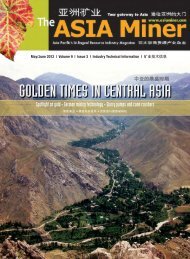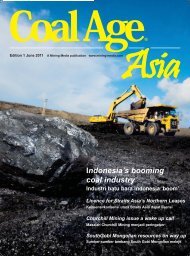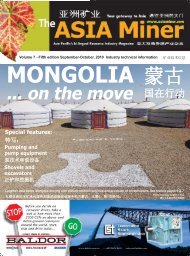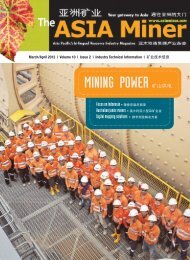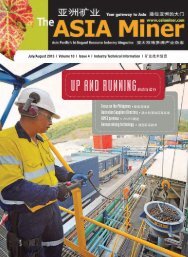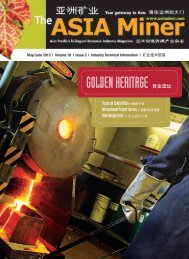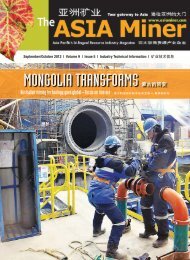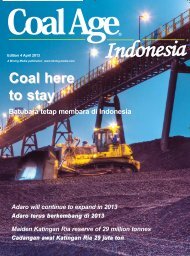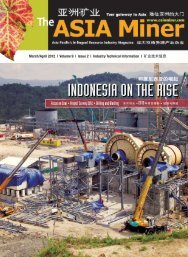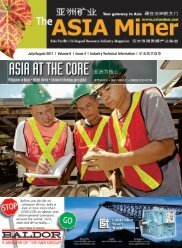MINING WELCOME 欢迎采矿 - The ASIA Miner
MINING WELCOME 欢迎采矿 - The ASIA Miner
MINING WELCOME 欢迎采矿 - The ASIA Miner
You also want an ePaper? Increase the reach of your titles
YUMPU automatically turns print PDFs into web optimized ePapers that Google loves.
Mongolia<br />
Haranga increases Selenge interest to 80%<br />
THE acquisition of a further 20% interest in a<br />
joint venture company that holds five exploration<br />
licences comprising the Selenge Iron<br />
Ore Project in northern Mongolia has boosted<br />
Haranga Resources’ ownership to 80%. <strong>The</strong><br />
ASX-listed company maintains full operational<br />
and management control of the joint venture.<br />
Selenge covers 600sqkm in the heart of<br />
Mongolia’s premier iron ore development region,<br />
about 200km north of Ulaanbaatar. <strong>The</strong><br />
project has access to the Trans-Mongolian<br />
rail line and nearby rail spurs.<br />
Drilling is ongoing with four diamond rigs in<br />
operation. Significant widths of iron mineralization<br />
have been intersected at all three of<br />
the targets drilled thus far and metallurgical<br />
test work has started in initial samples. <strong>The</strong><br />
company aims to define an initial JORC-compliant<br />
resource early in 2012.<br />
A total of 36 diamond core holes have been<br />
drilled for a total of 8366 metres. Drilling has<br />
focused on the Bayantsogt prospect where<br />
Haranga Resources’ projects in Mongolia. <strong>The</strong> company is focusing on the Selenge project in the country’s north.<br />
there are at least five major iron lodes each<br />
averaging about 20 metres and up to 103<br />
metres in apparent width.<br />
Assay results received to date include 28<br />
metres from 3 metres @ 30% iron, 17 metres<br />
from 50 metres @ 28%, 41 metres from 107<br />
metres @ 26 metres including 10 metres from<br />
113 metres @ 42%, 18 metres from 65 metres<br />
@ 31%, 5 metres from 106 metres @<br />
40%, 9 metres from 13 metres @ 39% including<br />
5 metres from 14 metres @ 47% and<br />
38 metres from 68 metres @ 24%.<br />
<strong>Miner</strong>alization at Bayantsogt is primarily<br />
hosted in Banded Magnetite Skarn and is<br />
similar in nature to the nearby 300 million<br />
tonne Eruu Gol deposit, which has proven<br />
amenable to low-cost mining and beneficiation,<br />
and is currently Mongolia’s largest<br />
iron ore export mine.<br />
Initial drilling at the larger Dund Bulag<br />
prospect has recently discovered significant<br />
widths of iron mineralization of a similar nature<br />
to Bayantsogt while mineralized intersections<br />
from initial drilling at the Huiten Gol<br />
prospect appear to be smaller in width but of<br />
a higher iron grade than Bayantsogt.<br />
All targets are associated with large magnetic<br />
anomalies and lie within a well-defined<br />
structural corridor that contains all of the<br />
known iron ore deposits in Selenge<br />
province, including Eruu Gol, which currently<br />
produces about 2.5 million tonnes of magnetite<br />
concentrate annually.<br />
Initial estimate for South Gobi Coal Project<br />
AN initial JORC resource estimate of 63.1<br />
million tonnes for Guildford Coal’s South Gobi<br />
Coal Project underpins the potential start-up<br />
open cut mining opportunity of 1-2 million<br />
tonnes annually for at least 20 years. <strong>The</strong> estimate<br />
comprises 38.2 million indicated and<br />
24.9 million inferred tonnes.<br />
<strong>The</strong> ASX-listed company lodged mining licence<br />
application for two tenements and expected<br />
to have these granted by the end of<br />
2011. It has completed scoping studies for<br />
the start-up operation and mining is targeted<br />
to begin by the end of the second quarter of<br />
2012 in the North Pit.<br />
<strong>The</strong> company will continue drilling on other<br />
key tenements in the South Gobi Project to define<br />
the JORC resource required to underpin<br />
the conceptual Central, West and East pit mine<br />
strategy for the project. Discussions with potential<br />
offtake partners have also commenced.<br />
Guildford’s interests in Mongolia are held<br />
through its 70%-owned subsidiary Terra Energy.<strong>The</strong><br />
South Gobi Coal Project comprises<br />
five exploration licences in South Gobi<br />
province about 1000km southwest of Ulaanbaatar<br />
and only about 60km from the Chinese<br />
border station town of Ceke.<br />
<strong>The</strong> project is also about 50km east of<br />
Nariin Sukhait which includes SouthGobi Resources’<br />
Ovoot Tolgoi mine and the MAK<br />
mine, which currently produce and export<br />
coking and thermal coal to customers in<br />
China. <strong>The</strong>se mines produce more than 5<br />
million tonnes annually of high volatile bituminous<br />
coals which are marketed as separate<br />
thermal and coking coal products.<br />
This coal is currently sold ROM at the mine<br />
gate to Chinese traders who transport the<br />
coal by truck to a Chinese border coal stockpile<br />
at Ceke where it is then transferred by rail<br />
to Chinese power stations and steel mills.<br />
<strong>The</strong> company also has the Middle Gobi<br />
Project, which consists of two exploration licences<br />
in Dundgovi province, about 200km<br />
south of Ulaanbaatar and about 200km<br />
west of the Mongolian railway grid with a logistics<br />
route to China via the Erlianhaote<br />
border crossing. Guildford recently announced<br />
a significant upgrade in exploration<br />
targets at its Mongolian projects to a range<br />
of 30 million to 1.38 billion tonnes<br />
32 | <strong>ASIA</strong> <strong>Miner</strong> | January/February 2012



